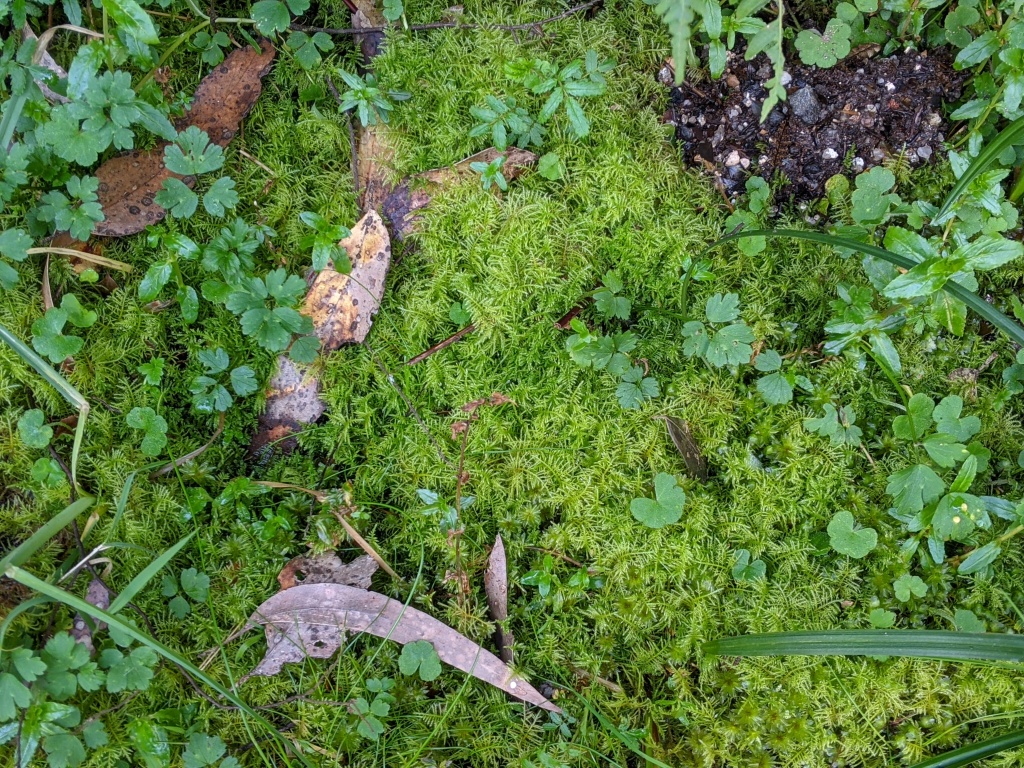Kindbergia
Dioicous. Asexual propagules absent. Mats, wefts or occasionally tufts (not in Victoria) on soil or on logs (not in Victoria). Stems creeping or ascending to erect (not in Victoria), regularly pinnately or slightly bipinnately branched, with scattered fascicles of rhizoids ventrally; paraphyllia sometimes present as longitudinal ridges; central strand present. Stem and branch leaves strongly differentiated, arranged around the stem and facing all directions, acumen more erect and slightly twisted when dry, well-spaced to loosely imbricate, plicate or not; apex acuminate; margin serrate toward apex, entire to serrulate near base, plane; laminal cells linear or linear-rhomboid, smooth, or a few near apex sharply prorate abaxially; alar cells weakly differentiated, quadrate to rectangular, often inflated. Stem leaves broadly triangular, erect-spreading to squarrose when moist, long-decurrent; costa extending 70–90 % of leaf length, sometimes subpercurrent (not in Victoria), ending in an abaxial spine or not. Branch leaves smaller and narrower than stem leaves, with more serrate margin, ovate to lanceolate, erect to erect-spreading when moist, shortly decurrent; costa extending 70–90 % of leaf length, sometimes subpercurrent (not in Victoria), more frequently ending in an abaxial spine. Seta rough or smooth. Capsule horizontal or pendent, asymmetric, ovoid to obloid, with an annulus. Calyptra cucullate, smooth, glabrous. Operculum long-rostrate. Peristome double; endostome segments nearly as long as exostome, with a high basal membrane; cilia present.
Seven species shared between north-west, central and South Africa, the islands of the Atlantic, the Americas, Europe, the Middle East, Japan, New Zealand and south-east Australia (Li et al. 2015); one species in Victoria.
In the last treatment of Australian Brachytheciaceae (Hedenäs 2002), this genus was included within Eurhynchium. However, Kindbergia is placed in a separate subfamily to Eurhynchium in various phylogenies based on various combinations of data including both morphological and DNA sequences and only DNA sequence datasets comprising regions from both chloroplast and nuclear genomes (Ignatov & Huttunen 2002; Huttunen & Ignatov 2004; Huttunen et al. 2007). Kindbergia differs from Eurhychium by the strongly differentiated stem and branch leaves, the presence of paraphyllia, and leaves with a few laminal cells toward the apex with distinct tooth-like prorae abaxially (Ochyra 1982; Ignatov & Huttunen 2002; Huttunen & Ignatov 2004).
 Spinning
SpinningHedenäs, L. (2002). An overview of the family Brachytheciaceae (Bryophyta) in Australia. Journal of the Hattori Botanical Laboratory 92: 51–90.
Huttunen, S.; Gardiner, A.A.; Ignatov, M.S. (2007). Advances in knowledge of the Brachytheciaceae (Bryophyta), in Newton, A.E. & Tangney, R (eds), Pleurocarpous mosses: systematics and evolution, pp. 117–143.. CRC Press, Boca Raton.
Huttunen, S.; Ignatov, M.S. (2004). Phylogeny of the Brachytheciaceae (Bryophyta) based on morphology and sequence level data. Cladistics 20: 151–183.
Ignatov, M.S.; Huttunen, S. (2002). Brachytheciaceae (Bryophyta) – a family of sibling genera. Arctoa 11: 245–296.
Li, M.; Jing, M.A.; Ignatov, M.S.; Tan, B.C.; Huttunen, S.; Zhao, J.-C.; Wang, Y.-F. (2015). Taxonomic re-assessment of Kindbergia (Brachytheciaceae, Bryophyta) in China, with a description of Pseudokindbergia gen. nov. Cryptogamie, Bryologie 36: 47–68.
Ochyra, R. (1982). Kindbergia (Brachytheciaceae, Musci), a new name for Stokesiella (Kindb.) Robins., hom. Illeg. Lindbergia 8: 53–54.
